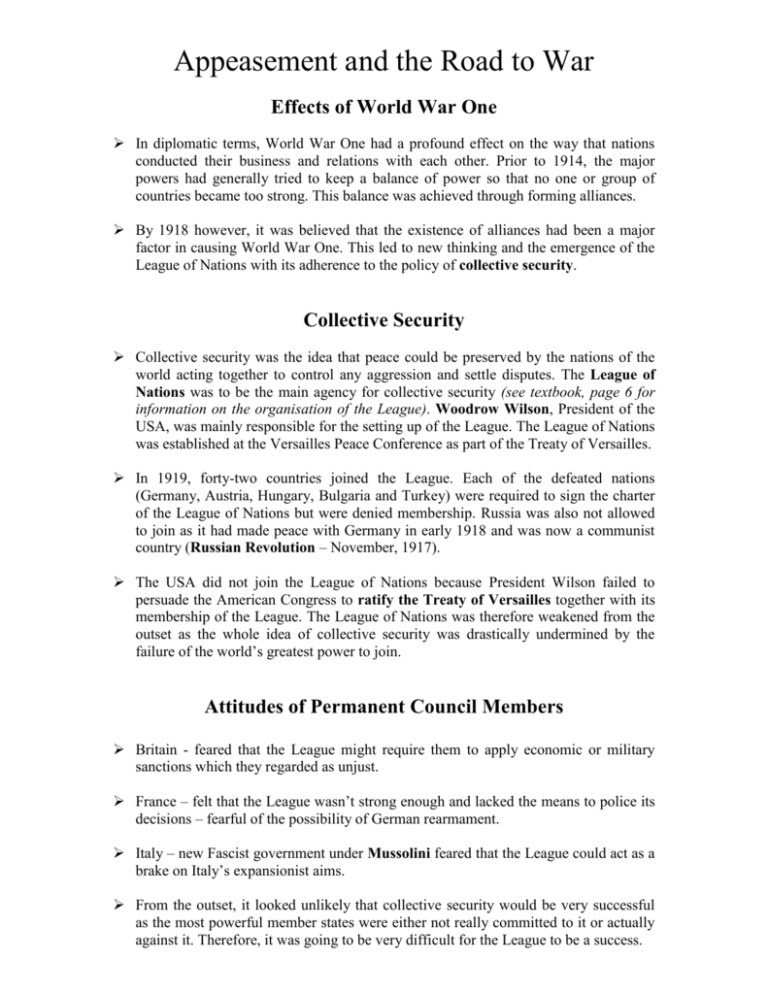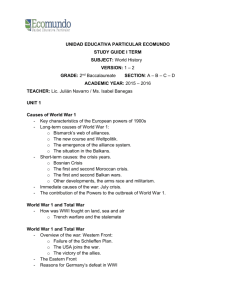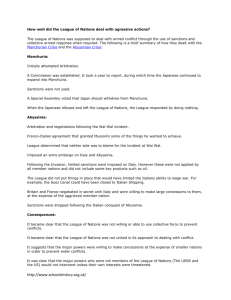Appeasement and the Road to War
advertisement

Appeasement and the Road to War Effects of World War One In diplomatic terms, World War One had a profound effect on the way that nations conducted their business and relations with each other. Prior to 1914, the major powers had generally tried to keep a balance of power so that no one or group of countries became too strong. This balance was achieved through forming alliances. By 1918 however, it was believed that the existence of alliances had been a major factor in causing World War One. This led to new thinking and the emergence of the League of Nations with its adherence to the policy of collective security. Collective Security Collective security was the idea that peace could be preserved by the nations of the world acting together to control any aggression and settle disputes. The League of Nations was to be the main agency for collective security (see textbook, page 6 for information on the organisation of the League). Woodrow Wilson, President of the USA, was mainly responsible for the setting up of the League. The League of Nations was established at the Versailles Peace Conference as part of the Treaty of Versailles. In 1919, forty-two countries joined the League. Each of the defeated nations (Germany, Austria, Hungary, Bulgaria and Turkey) were required to sign the charter of the League of Nations but were denied membership. Russia was also not allowed to join as it had made peace with Germany in early 1918 and was now a communist country (Russian Revolution – November, 1917). The USA did not join the League of Nations because President Wilson failed to persuade the American Congress to ratify the Treaty of Versailles together with its membership of the League. The League of Nations was therefore weakened from the outset as the whole idea of collective security was drastically undermined by the failure of the world’s greatest power to join. Attitudes of Permanent Council Members Britain - feared that the League might require them to apply economic or military sanctions which they regarded as unjust. France – felt that the League wasn’t strong enough and lacked the means to police its decisions – fearful of the possibility of German rearmament. Italy – new Fascist government under Mussolini feared that the League could act as a brake on Italy’s expansionist aims. From the outset, it looked unlikely that collective security would be very successful as the most powerful member states were either not really committed to it or actually against it. Therefore, it was going to be very difficult for the League to be a success. The League of Nations in the 1920s In the 1920s, the League of Nations had a number of successes settling disputes between minor powers e.g. Finland and Sweden in 1921. However, when it came to dealing with aggression on the part of major powers (and Council Members) such as France or Italy, the League was less successful. The French Invasion of the Ruhr in 1923 (see textbook, page 9) was a clear indicator of the League’s failures in the 1930s. The League was quite incapable of dealing with aggression by a large or middle-sized power. Collective security was not working well in the 1920s. Either it would have to be strengthened or a new strategy would have to be attempted. France’s Search for Security The French did not regard the Versailles settlement and the League as an adequate guarantee of their security. Furthermore, the Russian Revolution had denied them their pre-war ally. Consequently, in the 1920s, they became preoccupied with the need for security against future German aggression. In 1920, they concluded a military alliance with Belgium and they made a series of alliances with the new small states of Eastern Europe – Poland (1921), Czechoslovakia (1924), Rumania (1926), and Yugoslavia (1927) – ‘Little Entente’. This marked a departure from the ideal of collective security and a drift back to the bad, old habit of power block politics (Alliance System) which was held to be one of the major causes of the First World War. Improvements in International Relations, 1924-1929 Relations between France and Germany improved with the appointment of Aristide Briand and Gustav Stresemann as Foreign Ministers. These men believed in conciliation, rather than confrontation. In 1925, Britain, Germany, France and Italy signed a ‘Treaty of Mutual Guarantee’ at Locarno in Switzerland (‘Locarno Pact’). Germany accepted and guaranteed her frontiers with France and Belgium (including the demilitarized Rhineland), although she was still unwilling to accept her Eastern frontiers as a final arrangement. In 1926, Germany, with the approval of Briand, was admitted to the League as a Permanent Council Member. In 1928, American Secretary of State, Kellogg, together with Briand, drew up the ‘Pact of Paris’ (‘Kellogg-Briand Pact’), by which 62 nations promised not to use war as a means of resolving disputes – unless in self-defence. The reconciliation which Briand and Stresemann initiated might have given Europe peace if it had been given time to develop but the death of Stresemann in 1929, the Great Depression (1929-1935) and the consequent rise to power of Adolf Hitler meant this was not to be. Disarmament, 1919-1934 The League of Nations was keen to promote disarmament as countries such as Britain and the USA were convinced that the arms race had been a major cause of the First World War and that disarmament would provide security against further wars. However, very little progress was made in the 1920s and it wasn’t until 1932 that an International Disarmament Conference took place in Geneva, Switzerland. The British Prime Minister presented Conference with a detailed plan which set out the armed forces permitted to every country in Europe. The plan was welcomed at first but arguments soon broke out over the figures and, in the end, nothing came of it. When the British and Italians accepted a French plan in October 1933, the Germans (now under Nazi rule) withdrew from the Disarmament Conference and the League of Nations. In April, 1934, the Disarmament Conference was finally disbanded. Collective action had failed to solve the problem of armaments levels. It is hardly surprising that statesmen, concerned to preserve peace, should have wanted to try another approach. This led to the adoption of the policy of appeasement. The Manchurian Crisis, 1931 One night in September 1931, an explosion occurred which did minor damage to the Japanese controlled South Manchurian Railway at Mukden. The Japanese blamed the Chinese and took over all the important towns in Manchuria. By early January 1932, they had taken over the entire province. In February, they announced that Manchuria had become the independent Republic of Manchukuo. The Chinese maintained that the Japanese had sabotaged the track themselves as an excuse for the takeover and took their case to the League of Nations. A League Commission was sent to investigate the problem under the chairmanship of Britain’s Lord Lytton. The USA, France, Germany and Italy were also represented. In September 1932, a report was submitted to the League which rejected the Japanese claim that they had acted in self-defence. It recommended that China and Japan should negotiate to establish an independent state in Manchuria. Neither side was happy with this and eventually, in March 1933, Japan withdrew from the League. The Japanese regime in Manchukuo was not recognised but they got away with their act of aggression and this showed that a strong power could attack a weak one without fear of the League. Britain and France were unwilling to consider sanctions against Japan because of economic problems at home, the practical difficulties of waging war a long way from home and because of US reluctance to be involved. These events gave confidence to Mussolini and Hitler, and effectively encouraged them to defy the League in the pursuit of their expansionist policies. The Abyssinian Crisis, 1935 After the Manchurian Crisis of 1931, the Italian invasion of Abyssinia (present day Ethiopia) was the next important test for collective security. Benito Mussolini used the excuse of a boundary dispute between Abyssinia and Italian Somaliland to launch an invasion of Abyssinia. This was part of his plan to create a new Italian Empire. At first Mussolini sided with the Western Powers against Hitler. At the Stresa Conference, in 1935, Britain, France and Italy lined up in favour of the Treaty of Versailles and against German rearmament. They also reaffirmed their support for the independence of Austria. It was the Abyssinian crisis which destroyed the trust between Italy and the Western Powers. The conquest of Abyssinia (1935-1936) was the result of the Fascist policy of expansion and conquest and the Italian desire for colonies. Italian Nationalists had never forgotten Italy’s defeat by Abyssinian tribesmen in the battle of Adowa in 1896. Placed alongside Italian Eritrea and Somaliland, Abyssinia was seen as an Italian reserve. Fascism needed the prestige of a military victory. Mussolini’s view was that ‘a nation, to remain healthy, should make war every 25 years.’ However, Abyssinia was a member of the League of Nations and the League condemned Italy as an aggressor following the invasion launched in October 1935. It imposed economic sanctions - all League members were to ban imports from Italy, loans to Italy and the supply of war materials. However, the sanctions excluded oil and coal, essential in waging war. Moreover, in December 1935, the British and French foreign ministers, Samuel Hoare and Pierre Laval, put forward a compromise proposal (Hoare-Laval Pact) giving Italy over a half of Abyssinia if Mussolini agreed to stop the war. When the news of this leaked out, there was a storm of protest in Britain, as it seemed a betrayal of the Abyssinians and a surrender to aggression. Hoare was forced to resign but the damage to the League’s credibility was long-lasting. It showed the extent to which the British and French governments were afraid of upsetting Mussolini, whom they saw as an ally against Hitler. Indeed, the German army was able to take advantage of the Abyssinian crisis by reoccupying the Rhineland, contrary to the treaty of Versailles. Undeterred by the League, the Italians used aerial bombardment and poison gas to subdue the Abyssinians. By May 1936, their forces occupied Addis Ababa. Mussolini defiantly proclaimed the existence of the Italian Empire. When the Abyssinian Emperor Haile Selassie came to Geneva, to protest at the League of Nations, he was greeted by booing from Italian journalists. Italy had successfully defied the League of Nations in a war of aggression. The significance of this crisis was that it showed the inability of the League of Nations to stop a country that was determined to use force to achieve its aims. It showed that the ‘Pillars of the League’, Britain and France, put self-interest before collective security. Many historians consider the crisis over Abyssinia to be the rock on which the League was wrecked. A.J.P. Taylor wrote in his book, ‘The Origins of the Second World War’ that the real death of the League was in December 1935 (Hoare-Laval Pact) – “One day the League had seemed a powerful body imposing sanctions, the next day it had lost its influence.” From this point onwards, the Western Powers abandoned the pretence of solving disputes through the League and instead turned to the policy of appeasement. Hitler must have noted how, as in the Manchurian Crisis, Britain and France had appeared weak, indecisive and unwilling to act. This apparent weakness may have encouraged him to act aggressively in later crises. Italy and Germany drew closer together and in October 1936 the Rome-Berlin Axis was announced. Appeasement Another idea for preserving the peace, favoured by a growing number of political leaders especially in Britain and the USA, was appeasement. This has been defined as “… a disposition to avoid conflict by judicious concession and negotiation” (Professor Keith Robbins - Glasgow University). The difficulty lies in deciding when concessions are well-judged and reasonable and what these concessions should be. In the inter-war years, the use of appeasement as a policy for keeping the peace unfortunately led to the breakdown of collective security and the failure of the League of Nations. Concessions were repeatedly made at the expense of small nations in an attempt to buy off more aggressive powers such as Japan, Italy and Germany. The main reasons why the British government undertook a policy of appeasement in the 1930s are as follows: (1). They believed that Germany and Italy had been mistreated in the peace settlement of 1919 and that concessions had to be granted to correct decisions made in anger and bitterness at the end of a long and destructive war. (2). They believed that the people of Britain and the Empire e.g. Canada, were weary of war and would not accept another, even in support of collective security. (3). They believed that the British economy had been too severely damaged by the Great War and the Great Depression (1929-1935) to sustain another major war. (4). They believed that the armed forces of Britain and France were neither prepared nor equipped for war and needed time to rearm. (5). They believed that Russian Communism or Bolshevism (extreme Left) rather than Fascism (extreme Right) was the main threat to western democracy. (For more information on the reasons behind appeasement, see textbook, pages 54-58.) Hitler’s Foreign Policy, 1933-1935 Aims of Hitler’s Foreign Policy The main aims of Hitler’s foreign policy were set out in the 1920 Nazi Party Programme and in Hitler’s book, ‘Mein Kampf’ (‘My Struggle’), written in 1924. The short-term policy was to remove the terms of the Treaty of Versailles which placed restrictions on Germany. Hitler knew this might take 10 years or more to achieve but would be very popular with the German people. For example, he was determined to create a ‘Gross Deutschland’ (‘Greater Germany’) which included Austria and the German minorities living in Czechoslovakia, Poland and other states. Success in this short-term strategy would lead to success in his long-term policy which was racial and territorial. It was chiefly aimed at gaining territory in the East at the expense of ‘inferior races’ – ‘Lebensraum’ (living space). This strategy would lead to Jews being exterminated, Slavic races being turned into a slave labour force and Communism being crushed. New economic resources would become available to Germany which would strengthen its people and help develop ‘the Master Race’ i.e. the superior Germanic race. Hitler and Disarmament/League of Nations In international relations, Hitler tried to present himself as a peaceful man acting in defence of the German people. In February 1932, the League of Nations had finally got a disarmament conference under way in Geneva. In May 1933, Hitler demanded parity in armaments (equal sized armed forces) with the French, stating that it was unfair that Germany had been forced to disarm whilst France had not. If France refused to disarm, then Germany would begin to rearm. The French were unwilling to disarm as they were acutely aware of their inferior industrial resources and smaller population, and were obsessed with security as a direct result of invasions by Germany in 1870 and 1914. Hitler withdrew Germany from both the Conference and the League of Nations in October 1933. He claimed that these organisations were merely a French conspiracy to keep Germany a second-rate power, incapable of self-defence. This was another blow for the idea of collective security as another major power was now no longer a member of the League of Nations. In April, 1934, the Disarmament Conference was finally disbanded. Many British politicians were openly sympathetic towards Germany because they felt guilty about the severity of the Treaty of Versailles. In November 1933, a plebiscite (a vote) showed that the German people overwhelmingly supported Hitler’s actions. Anschluss Postponed, July 1934 Since coming to power, the Nazis had financed and encouraged the Austrian Nazi Party. The Austrian Nazis ran a campaign of intimidation, terrorism and violent propaganda. Dollfuss, the Austrian Chancellor was finally forced to have the party banned. On 25th July 1934, the Nazis assassinated Dollfuss as part of an attempted coup d’etat/Putsch (armed rising) intended to force the union with Germany. The Italian government, led by Benito Mussolini, was alarmed at this development. The Italians had no desire for a common frontier with Hitler. The South Tyrol, gained by Italy from Austria through the Treaty of St. Germain in 1919, had a substantial German minority. Mussolini also feared that Hitler would use Austria as a base to undermine Italy’s influence in the Balkans. Consequently, 100,000 Italian troops were massed on Italy’s border with Austria. Hitler was taken aback by the intensity of the reaction he had caused and was forced to disown the Putsch. German Rearmament In March 1934, the published German military budget showed substantial increases, indicating that Germany was rearming. In March 1935, Hermann Goring, one of Hitler’s ministers, revealed the existence of the Luftwaffe (airforce) and general conscription to the armed forces was reintroduced. Both of these actions were against the Treaty of Versailles. Reaction to German Rearmament In response to these developments, there was an attempt to reassert collective security. In April 1935, the French organized a conference at Stresa in Italy attended by the Prime Ministers and Foreign Ministers of Britain, France and Italy. A formal protest against Hitler’s flouting of the disarmament clauses of the Treaty of Versailles was issued. However, the ‘Stresa Front’ was short-lived, wrecked by the quarrel which arose from Italy’s invasion of Abyssinia (Ethiopia). The Soviet Union was also worried about Hitler’s behaviour. In September 1934, she joined the League of Nations and in May 1935, she signed a ‘Mutual Assistance Pact’ with France. The British attitude to German Rearmament was to try and limit it by negotiation rather than stop it by force or threat i.e. appeasement. In June 1935, Britain and Germany signed the ‘Anglo-German Naval Agreement’ by which Britain agreed that Germany could build up to 35% of Britain’s naval strength and could equal the submarine strength of the British Empire. This was despite the fact that the Treaty of Versailles had forbidden Germany to have any U-boats at all. The effect of this agreement was to destroy the Stresa Front. Both the French and the Italians felt that Britain was unpredictable and unreliable, and likely to make conflicting agreements with her friends and her supposed enemies.







